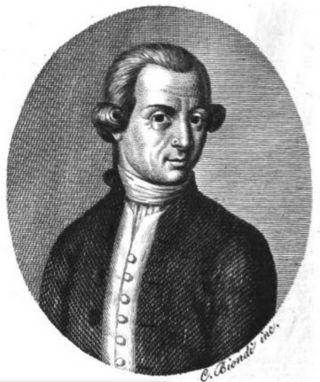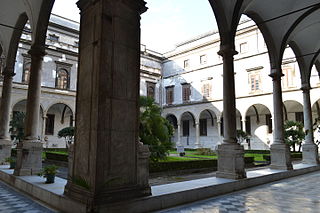
The House of Orsini is an Italian noble family that was one of the most influential princely families in medieval Italy and Renaissance Rome. Members of the Orsini family include five popes: Stephen II (752–757), Paul I (757–767), Celestine III (1191–1198), Nicholas III (1277–1280), and Benedict XIII (1724–1730). The family also included 34 cardinals, numerous condottieri, and other significant political and religious figures. The Orsini are part of the Black nobility who were Roman aristocratic families who supported the Popes in the governance of the Papal States.

The Real Teatro di San Carlo, as originally named by the Bourbon monarchy but today known simply as the Teatro (di) San Carlo, is a historic opera house in Naples, Italy, connected to the Royal Palace and adjacent to the Piazza del Plebiscito. It is the oldest continuously active venue for opera in the world, having opened in 1737, decades before either Milan's La Scala or Venice's La Fenice.

Carlo Filangieri, prince of Satriano, was a Neapolitan soldier and statesman. He was the son of Gaetano Filangieri, a celebrated philosopher and jurist, and father of Gaetano Filangieri, prince of Satriano, an art historian and collector.

Gaetano Filangieri was an Italian jurist and philosopher.

Vincenzo Petagna was an Italian biologist, physician and entomologist. He was appointed as director of the small botanical garden pertaining to the Monastery of Santa Maria di Monte Oliveto in central Naples. He was also the teacher of Antonio Savaresi. The plant Petagnaea gussonei has been named after him.
Angiolillo Arcuccio was an Italian painter of the early Renaissance. Few works are authenticated. He is best exemplified by the Annunciation altarpiece (1483) at the church of the Annunciation just outside Sant'Agata de' Goti, north of Naples. Ferrari and other scholars note a Flemish influence in later paintings. He collaborated with Gaspare de Orta in painting for a salon in Castelnuovo.
Scipione Cappella was an Italian historical painter. He was initially trained with his uncle, Domenico Viola, but then became a pupil of Francesco Solimena. He was known mainly for his ability to make copies of the latter master's paintings.

Giordano Filangieri was a Neapolitan nobleman, the son of Giordano, lord of Nocera, and Oranpiassa, and younger brother of Riccardo. Both he and his brother became involved in the high politics of the Kingdom of Sicily.
AldoinoFilangieri di Candida was a nobleman in the Kingdom of Naples. He was the son of Giordano of the Filangieri and an unnamed woman, the sister of Aldoino di Cicala, after whom he was named and from whom he inherited his fief. He inherited his uncle's fief of Candida on his father's death. He was the father of the Filangieri di Candida.

Richard (Riccardo) Filangieri (c.1195–1254/63) was an Italian nobleman who played an important part in the Sixth Crusade in 1228–9 and in the War of the Lombards from 1229–43, where he was in charge of the forces of Frederick II, Holy Roman Emperor, battling forces on the other side, local barons first led by John of Ibelin, Old Lord of Beirut. During the first half of his career Richard was a Ghibelline, but during the second a Guelph. He was a member of the Filangieri family of Sicily.

Luigi de' Medici was an Italian nobleman, legal scholar, diplomat and statesman, who served as Prime minister of the Kingdom of the Two Sicilies and the legal representative at the Congress of Vienna.

Francesco Saverio Salfi or Franco Salfi was an Italian writer, politician and librettist.

The church of Santi Severino e Sossio and the annexed monastery are located on via Bartolommeo Capasso in Naples, Italy.

The House of Caracciolo is a prominent aristocratic noble family that originated in the city of Naples. The Caracciolos are considered one of the most important families in the history of the Kingdom of Naples, and also held relevant posts in the Spanish Empire, Holy Roman Empire, and the Roman Catholic Church.

The State Archives of Naples, with its more than 50,000 linear meters of book and document shelving, is of fundamental importance for the history of southern Italy from the 10th century to today. The archives are housed in the cloisters of the Church of Saints Severino and Sossio.
Gaetano Filangieri, prince of Satriano was an art historian and collector who founded the Museo Civico Filangieri. He lived in the Kingdom of the Two Sicilies and then in the Kingdom of Italy.
Enrico Filangieri was an Italian nobleman and Dominican friar who served as the archbishop of Bari in the Kingdom of Sicily from May 1252 until his death.

The d'Afflitto family is an ancient princely family originally from Amalfi, documented since the IX century, and spread throughout southern Italy.

The Enlightenment in Italy was a cultural and philosophical movement that began in the second half of the eighteenth century, characterized by the discussion of the epistemological, ethical, and political issues of the Enlightenment thought of the eighteenth century.

Leodoro Piscicello Zurolo - was first a valiant Byzantine soldier, then a leader during the regency of Basil II of Byzantium known as the Bulgarian, who enlisted in the Byzantine imperial army. As a soldier of the Byzantine imperial ranks, he was then raised to the rank of élite knight in the so-called schola and, subsequently, to that of general who was sent by Basil II to the Duchy of Naples.














